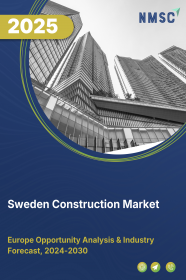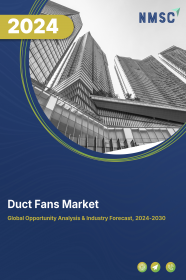
Sweden Construction Market by Type (Renovation and New Construction), and by Sector (Real Estate, Infrastructure, and Industrial) – Opportunity Analysis and Industry Forecast, 2024–2030
Industry: Construction & Manufacturing | Publish Date: 22-May-2025 | No of Pages: 143 | No. of Tables: 108 | No. of Figures: 53 | Format: PDF | Report Code : CM2206
US Tariff Impact on Sweden Construction Market
Trump Tariffs Are Reshaping Global Business
Sweden Construction Market Overview
The Sweden Construction Market size was valued at USD 52.43 billion in 2023, and is predicted to reach USD 77.80 billion by 2030, at a CAGR of 7.9% from 2024 to 2030.
The construction market, also known as infrastructure market, plays a vital role in the economy by overseeing the entire lifecycle of various physical structures, including infrastructure, buildings, and facilities. This industry encompasses a wide array of projects, ranging from residential, commercial, and industrial developments to civil engineering and institutional infrastructure endeavors.
Collaboration among various stakeholders, including architects, engineers, contractors, suppliers, developers, investors, and government agencies, is essential for its operations. Positioned for growth, the industry is being driven by an increased emphasis on environmentally sustainable practices, such as the integration of green building materials and energy-efficient designs. Furthermore, factors such as rising per capita income in emerging economies and low-interest rates in developed nations are expected to further propel the expansion of the infrastructure market.
Infrastructure Developments in sweden is Driving Market Growth
The construction market in Sweden is witnessing substantial growth, propelled by the surge of large-scale infrastructure developments. Noteworthy projects in 2024, such as the Vidnoye Residential Complex, Pride Residential Complex, Transport Hub Development, Khasavyurt Bypass, and Pyatigorsk Beshtaugorskoe Highway Reconstruction, significantly contributed to the expansion of the industry within the country. These infrastructural endeavors underscore Sweden's commitment to modernization and economic progress.
Focus on Green Construction and Industrial Expansion is Fueling Growth of the Market
The country has adopted ambitious environmental goals, pushing for energy-efficient buildings, the use of low-emission construction materials, and green certification standards such as BREEAM and LEED. This shift towards eco-friendly construction is further supported by incentives for retrofitting old buildings and integrating renewable energy systems. Moreover, Sweden's growing industrial base, especially in clean energy, battery manufacturing, and data centers, is also fueling demand for industrial infrastructure.
Regulatory Complexities Hurdles in Market Growth
Navigating regulatory complexities presents a formidable barrier in the Sweden construction market. Infrastructure projects face hurdles due to the intricate network of government regulations and permitting procedures. Infrastructure endeavors require numerous permits and approvals from governmental bodies at local, regional, and national levels. These mandates encompass adherence to zoning regulations, environmental assessments, compliance with building codes, safety standards, and various regulatory stipulations. The lengthy process of acquiring permits, bureaucratic inefficiencies, and disparities in regulations among different jurisdictions can substantially prolong project timelines and inflate costs. Furthermore, fluctuations in regulations or unexpected policy changes can disrupt ongoing projects and deter potential investments.
Integration of Digitalization and BIM Presents Lucrative Opportunity for Market Expansion
The construction industry is undergoing a transformative phase with the integration of digitalization and the adoption of Building Information Modeling (BIM). Leveraging advanced technologies such as BIM enhances efficiency, accuracy, and collaboration across diverse projects. BIM, a sophisticated 3D modeling tool, empowers stakeholders to generate and manage digital representations of structures and infrastructure, facilitating improved coordination and communication among project teams.
Competitive Landscape
The market players operating in the Sweden infrastructure industry include JM AB, NCC AB, Peab AB, SKANSKA AB, Veidekke Sverige, Serneke Group AB, AF Gruppen Sverige, Svevia AB, Erlandsson Holding AB , Wastbygg Gruppen AB, Jan Frohlund Byggnadsfirma AB, Bygglogistik , EGH Bygg, Caverion Corporation, BDX Foretagen AB and others.
Sweden Construction Market Key Segments
By Type
-
Renovation
-
New Construction
By Sector
-
Real Estate
-
Residential
-
Affordable
-
Luxury
-
-
Commercial
-
Retail Buildings
-
Office Buildings
-
Hospitality
-
Healthcare Facilities
-
Educational Institutes
-
Entertainment Ventures
-
-
-
Infrastructure
-
Transportation
-
Airport
-
Port
-
Rail
-
Road
-
-
Water and Wastewater
-
Energy
-
Telecommunication
-
-
Industrial
-
Manufacturing Plant
-
Warehouses
-
Power Plants
-
Oil Refineries
-
Chemical Plants
-
Key Players
-
JM AB
-
NCC AB
-
Peab AB
-
SKANSKA AB
-
Veidekke Sverige
-
Serneke Group AB
-
AF Gruppen Sverige
-
Svevia AB
-
Erlandsson Holding AB
-
Wastbygg Gruppen AB
-
Jan Frohlund Byggnadsfirma AB
-
Bygglogistik
-
EGH Bygg
-
Caverion Corporation
-
BDX Foretagen AB
REPORT SCOPE AND SEGMENTATION:
|
Parameters |
Details |
|
Market Size in 2023 |
USD 52.43 Billion |
|
Revenue Forecast in 2030 |
USD 77.80 Billion |
|
Growth Rate |
CAGR of 7.9% from 2024 to 2030 |
|
Analysis Period |
2023–2030 |
|
Base Year Considered |
2023 |
|
Forecast Period |
2024–2030 |
|
Market Size Estimation |
Billion (USD) |
|
Growth Factors |
|
|
Companies Profiled |
15 |
|
Market Share |
Available for 10 companies |
|
Customization Scope |
Free customization (equivalent up to 80 working hours of analysts) after purchase. Addition or alteration to country, regional, and segment scope. |
|
Pricing and Purchase Options |
Avail customized purchase options to meet your exact research needs. |

















 Speak to Our Analyst
Speak to Our Analyst

















